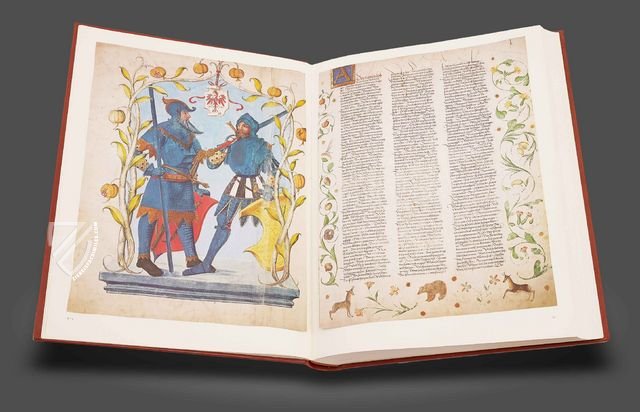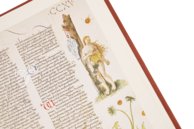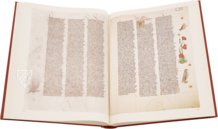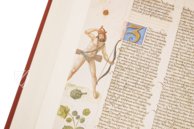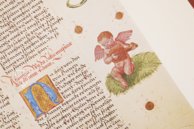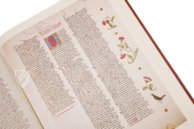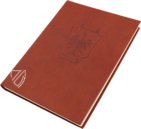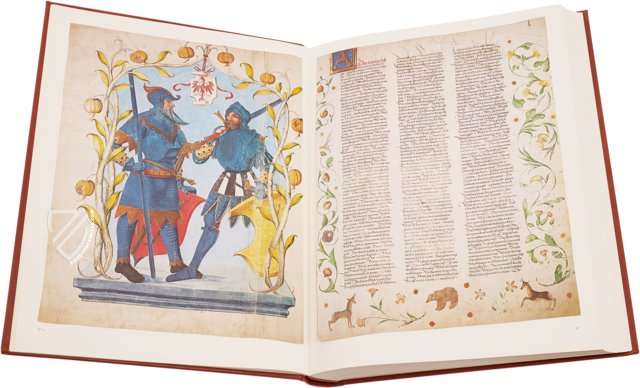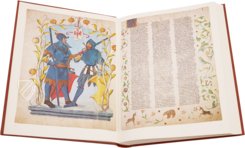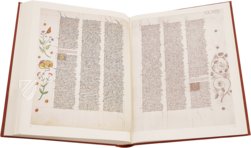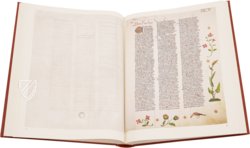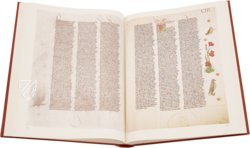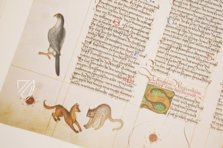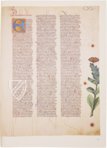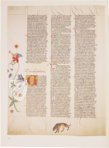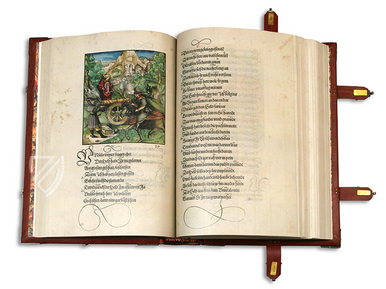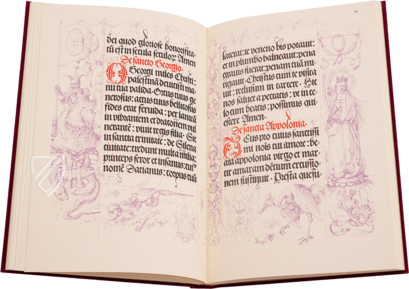Ambras Book of Heroes
(1,000€ - 3,000€)
The Ambras Book of Heroes is just one of the fantastic illuminated manuscript commissioned by Maximilian I, King of the Germans and Holy Roman Emperor. It encompasses numerous Middle High German epics, among them the Nibelungenlied, Hartmann’s Erec and Iwein, and Ulrich of Lichtenstein’s Frauenbuch – all valuable fundamental texts for medieval research. It is a "giant book", being ca. 40 x 36 cm in size and counting 486 pages, and its scribe, Hans Reid, took twelve years to write its incredibly neat, uniform, and decorated text. The book features a wonderful pictorial program including many of the flora and fauna one would expect, as well as symbols alluding to its imperial patron and his personal symbols of rule, like the pomegranate.
Ambras Book of Heroes
The Ambras Book of Heroes is a significant work in the tradition of high and late medieval German epic poetry. It encompasses numerous Middle High German epics, among them the Nibelungenlied, Hartmann’s Erec and Iwein, and Ulrich of Lichtenstein’s Frauenbuch, all valuable basic texts for medieval research. The scribe Hans Ried, customs officer on the Eisack near Bolzano, copied the Book of Heroes for King Maximilian I, who had commissioned it for his own use. This "giant book", as it was also called because of its oversized format (406 x 360 mm) and for which no less than 122 calves had lost their skins, is fascinating due to the accomplished beauty of its script, which has been executed in uniform lettering from the first to the last page. 118 of the manuscript’s 486 pages (243 folios) are ornate with elaborately painted initials and with imaginative marginal decoration, making it a unique document for the history of art as well.
A Masterpiece of Calligraphy
The Ambras Book of Heroes was written down in German cancelleresca script and masterly executed by the experienced calligrapher Hans Ried. Its unified form, which is maintained throughout the entire book, lends the script a particular character, and it deserves to bear its own name in scribal history as the "script of the Book of Heroes". The overall impression of Ried’s handwriting is also characterized by the numerous, frequently hair-fine diacritic marks which often puzzled those who had to transcribe texts from the Ambras Book of Heroes by use of film or partial copies reduced in size. The facsimile version in the original format thus constitutes a valuable replacement of the manuscript. Writing down the Ambras Book of Heroes took over twelve years, a very long period of time, even for a manuscript of such huge dimensions. Ried was therefore reproached as being a “clever lazybone”, a reproach which, however, seems unjustified, as he was not only concentrating on accomplishing the Book of Heroes alone. Moreover, the experienced calligrapher put great diligence into the script and the elaborate decoration of the first and last lines of each page, so that we may estimate a maximum performance of probably three columns (= one page) per day.
The Illumination
The numerous small initials were added at a later stage, perhaps by a special rubricist, whereas the large initials were executed by one painter in a single pass. The initials are painted in various colors, mostly red or blue, on golden, finely patterned grounds, while some initials are executed in blazing gold upon a colored background. The imaginative ornamentation which decorates 118 pages of the book is loosely dispersed across the broad margins. Numerous plants and animals, which impress the beholder with their naturalistic and detailed execution, as well as depictions of human figures, betray the hand of an experienced master who seems to have derived some of the motifs in free variation from books of hours from the Low Countries. The marginal decorations serve as decorative embellishment and are sometimes closely linked to the contents, such as on fol. 212v where the depiction of a sword broken on the scale armor of a dragon illustrates the relevant text on the same page. The frontispiece of the Ambras Book of Heroes shows two men in harness, probably the heroes guarding the entry to the book named after them. An immediate reference to the patron and eventual owner of the manuscript is the depiction of pomegranates, one of Maximilian’s inscribed emblems, which might be interpreted as symbolic metamorphoses of the orb, in allusion to the world’s domination by the emperor.
The Content of the Ambras Book of Heroes:
1. Der Stricker, Frauenlob
2. Moritz von Craon (only manuscript)
3. Hartmann von Aue, Iwein (manuscript D)
4. Hartmann von Aue, Das (erste) Büchlein
5. Hartmann von Aue, the so called Zweite Büchlein
6. Heinrich von dem Türlin, Der Mantel
7. Hartmann von Aue, Erec
8. Dietrichs Flucht (manuscript D)
9. Die Rabenschlacht (manuscript D)
10. Nibelungenlied (manuscript D)
11. Die Klage (incomplete)
12. Kudrun (only manuscript)
13. Biterwolf (only manuscript)
14. Ortnit (manuscript A)
15. Wolfdietrich A (only manuscript)
16. Die Böse Frau (only manuscript)
17. Herrant von Wildon, Die getreue Hausfrau (only manuscript)
18. Herrant von Wildon, Der verkehrte Wirt (only manuscript)
19. Herrant von Wildon, Der nackte Kaiser (only manuscript)
20. Herrant von Wildon, Die Katze (only manuscript)
21. Ulrich von Lichtenstein, Frauenbuch (only manuscript)
22. Wernher der Gartenaere, Meister Helmbrecht (manuscript A)
23. Der Stricker, Pfaffe Amis
24. Wolfram von Eschenbach, Titurel (fragment)
25. Der Priester Johann (fragment)
Codicology
- Alternative Titles
- Ambraser Heldenbuch
- Size / Format
- 486 pages / 46.0 × 36.0 cm
- Origin
- Italy
- Date
- 1504–1517
- Epochs
- Style
- Genre
- Language
- Illustrations
- 1 full-page illustration and miniatures in the margin
- Patron
- Emperor Maximilian I
- Artist / School
- Hans Ried (scribe)
#1 Ambraser Heldenbuch
Language: German
With 13 illustrations.
A scholarly documentary written by Franz Unterkircher gives an introduction to the making and history of the Book of Heroes and the script and decoration of the manuscript. It provides a description of the codicological analysis as well as a summary of its contents. In addition, it lists the registered documents of all records referring to the scribe Hans Ried and the Ambras Book of Heroes, with a reproduction and transcription of the five most eminent documents in the illustration section.
The Ambras Book of Heroes contains:
1. Der Stricker, Frauenlob
2. Moritz von Craon (sole manuscript in existence)
3. Hartmann von Aue, Iwein (manuscript d)
4. Hartmann von Aue, Das (erste) Büchlein
5. Das sogenannte zweite Büchlein
6. Heinrich von Türlin, Der Mantel
7. Hartmann von Aue, Erec
8. Dietrichs Flucht / Dietrich’s Flight (manuscript d)
9. Die Rabenschlacht / The Battle of Ravenna (manuscript d)
10. Die Klage (unfinished)
11. Kudrun (only manuscript)
12. Biterwolf / Biterolf (sole manuscript in existence)
13. Ortnit (manuscript A)
14. Wolfdietrich A (sole manuscript in existence)
15. Die Böse Frau (sole manuscript in existence)
16. Herrant von Wildon, Die getreue Hausfrau (sole manuscript in existence)
17. Herrant von Wildon, Der verkehrte Wirt (sole manuscript in existence)
18. Herrant von Wildon, Der nackte Kaiser (sole manuscript in existence)
19. Herrant von Wildon, Die Katze (sole manuscript in existence)
20. Ulrich von Lichtenstein, Frauenbuch (sole manuscript in existence)
21. Wernher der Gärtner, Meier Helmbrecht (manuscript A)
22. Der Stricker, Pfaffe Amis
23. Wolfram von Eschenbach, Titurel (fragment)
24. Der Priester Johann (fragment)
(1,000€ - 3,000€)
- Treatises / Secular Books
- Apocalypses / Beatus
- Astronomy / Astrology
- Bestiaries
- Bibles / Gospels
- Chronicles / History / Law
- Geography / Maps
- Saints' Lives
- Islam / Oriental
- Judaism / Hebrew
- Single Leaf Collections
- Leonardo da Vinci
- Literature / Poetry
- Liturgical Manuscripts
- Medicine / Botany / Alchemy
- Music
- Mythology / Prophecies
- Psalters
- Other Religious Books
- Games / Hunting
- Private Devotion Books
- Other Genres
- Afghanistan
- Armenia
- Austria
- Belgium
- Belize
- Bosnia and Herzegovina
- China
- Colombia
- Costa Rica
- Croatia
- Cyprus
- Czech Republic
- Denmark
- Egypt
- El Salvador
- Ethiopia
- France
- Germany
- Greece
- Guatemala
- Honduras
- Hungary
- India
- Iran
- Iraq
- Israel
- Italy
- Japan
- Jordan
- Kazakhstan
- Kyrgyzstan
- Lebanon
- Liechtenstein
- Luxembourg
- Mexico
- Morocco
- Netherlands
- Palestine
- Panama
- Peru
- Poland
- Portugal
- Romania
- Russia
- Serbia
- Spain
- Sri Lanka
- Sweden
- Switzerland
- Syria
- Tajikistan
- Turkey
- Turkmenistan
- Ukraine
- United Kingdom
- United States
- Uzbekistan
- Vatican City
- A. Oosthoek, van Holkema & Warendorf
- Aboca Museum
- Ajuntament de Valencia
- Akademie Verlag
- Akademische Druck- u. Verlagsanstalt (ADEVA)
- Aldo Ausilio Editore - Bottega d’Erasmo
- Alecto Historical Editions
- Alkuin Verlag
- Almqvist & Wiksell
- Amilcare Pizzi
- Andreas & Andreas Verlagsbuchhandlung
- Archa 90
- Archiv Verlag
- Archivi Edizioni
- Arnold Verlag
- ARS
- Ars Magna
- ArtCodex
- AyN Ediciones
- Azimuth Editions
- Badenia Verlag
- Bärenreiter-Verlag
- Belser Verlag
- Belser Verlag / WK Wertkontor
- Benziger Verlag
- Bernardinum Wydawnictwo
- BiblioGemma
- Biblioteca Apostolica Vaticana (Vaticanstadt, Vaticanstadt)
- Bibliotheca Palatina Faksimile Verlag
- Bibliotheca Rara
- Boydell & Brewer
- Bramante Edizioni
- Bredius Genootschap
- Brepols Publishers
- British Library
- C. Weckesser
- Caixa Catalunya
- Canesi
- CAPSA, Ars Scriptoria
- Caratzas Brothers, Publishers
- Carus Verlag
- Casamassima Libri
- Centrum Cartographie Verlag GmbH
- Chavane Verlag
- Christian Brandstätter Verlag
- Circulo Cientifico
- Club Bibliófilo Versol
- Club du Livre
- CM Editores
- Collegium Graphicum
- Collezione Apocrifa Da Vinci
- Comissão Nacional para as Comemorações dos Descobrimentos Portugueses
- Coron Verlag
- Corvina
- CTHS
- D. S. Brewer
- Damon
- De Agostini/UTET
- De Nederlandsche Boekhandel
- De Schutter
- Deuschle & Stemmle
- Deutscher Verlag für Kunstwissenschaft
- DIAMM
- Droz
- E. Schreiber Graphische Kunstanstalten
- Ediciones Boreal
- Ediciones Grial
- Ediclube
- Edições Inapa
- Edilan
- Editalia
- Edition Deuschle
- Edition Georg Popp
- Edition Leipzig
- Edition Libri Illustri
- Editiones Reales Sitios S. L.
- Éditions de l'Oiseau Lyre
- Editions Medicina Rara
- Editorial Casariego
- Editorial Mintzoa
- Editrice Antenore
- Editrice Velar
- Edizioni Edison
- Egeria, S.L.
- Eikon Editores
- Electa
- Emery Walker Limited
- Enciclopèdia Catalana
- Eos-Verlag
- Ephesus Publishing
- Ernst Battenberg
- Eugrammia Press
- Extraordinary Editions
- Fackelverlag
- Facsimila Art & Edition
- Facsimile Editions Ltd.
- Facsimilia Art & Edition Ebert KG
- Faksimile Verlag
- Feuermann Verlag
- Folger Shakespeare Library
- Franco Cosimo Panini Editore
- Friedrich Wittig Verlag
- Fundación Hullera Vasco-Leonesa
- G. Braziller
- Gabriele Mazzotta Editore
- Gebr. Mann Verlag
- Gesellschaft für graphische Industrie
- Getty Research Institute
- Giovanni Domenico de Rossi
- Giunti Editore
- Graffiti
- Grafica European Center of Fine Arts
- Guido Pressler
- Guillermo Blazquez
- Gustav Kiepenheuer
- H. N. Abrams
- Harrassowitz
- Harvard University Press
- Helikon
- Hendrickson Publishers
- Henning Oppermann
- Herder Verlag
- Hes & De Graaf Publishers
- Hoepli
- Holbein-Verlag
- Houghton Library
- Hugo Schmidt Verlag
- Idion Verlag
- Il Bulino, edizioni d'arte
- ILte
- Imago
- Insel Verlag
- Insel-Verlag Anton Kippenberger
- Instituto de Estudios Altoaragoneses
- Instituto Nacional de Antropología e Historia
- Introligatornia Budnik Jerzy
- Istituto dell'Enciclopedia Italiana - Treccani
- Istituto Ellenico di Studi Bizantini e Postbizantini
- Istituto Geografico De Agostini
- Istituto Poligrafico e Zecca dello Stato
- Italarte Art Establishments
- Jan Thorbecke Verlag
- Johnson Reprint Corporation
- Josef Stocker
- Josef Stocker-Schmid
- Jugoslavija
- Karl W. Hiersemann
- Kasper Straube
- Kaydeda Ediciones
- Kindler Verlag / Coron Verlag
- Kodansha International Ltd.
- Konrad Kölbl Verlag
- Kurt Wolff Verlag
- La Liberia dello Stato
- La Linea Editrice
- La Meta Editore
- Lambert Schneider
- Landeskreditbank Baden-Württemberg
- Leo S. Olschki
- Les Incunables
- Liber Artis
- Library of Congress
- Libreria Musicale Italiana
- Lichtdruck
- Lito Immagine Editore
- Lumen Artis
- Lund Humphries
- M. Moleiro Editor
- Maison des Sciences de l'homme et de la société de Poitiers
- Manuscriptum
- Martinus Nijhoff
- Maruzen-Yushodo Co. Ltd.
- MASA
- Massada Publishers
- McGraw-Hill
- Metropolitan Museum of Art
- Militos
- Millennium Liber
- Müller & Schindler
- Nahar - Stavit
- Nahar and Steimatzky
- National Library of Wales
- Neri Pozza
- Nova Charta
- Oceanum Verlag
- Odeon
- Orbis Mediaevalis
- Orbis Pictus
- Österreichische Staatsdruckerei
- Oxford University Press
- Pageant Books
- Parzellers Buchverlag
- Patrimonio Ediciones
- Pattloch Verlag
- PIAF
- Pieper Verlag
- Plon-Nourrit et cie
- Poligrafiche Bolis
- Presses Universitaires de Strasbourg
- Prestel Verlag
- Princeton University Press
- Prisma Verlag
- Priuli & Verlucca, editori
- Pro Sport Verlag
- Propyläen Verlag
- Pytheas Books
- Quaternio Verlag Luzern
- Reales Sitios
- Recht-Verlag
- Reichert Verlag
- Reichsdruckerei
- Reprint Verlag
- Riehn & Reusch
- Roberto Vattori Editore
- Rosenkilde and Bagger
- Roxburghe Club
- Salerno Editrice
- Saltellus Press
- Sandoz
- Sarajevo Svjetlost
- Schöck ArtPrint Kft.
- Schulsinger Brothers
- Scolar Press
- Scrinium
- Scripta Maneant
- Scriptorium
- Shazar
- Siloé, arte y bibliofilia
- SISMEL - Edizioni del Galluzzo
- Sociedad Mexicana de Antropología
- Société des Bibliophiles & Iconophiles de Belgique
- Soncin Publishing
- Sorli Ediciones
- Stainer and Bell
- Studer
- Styria Verlag
- Sumptibus Pragopress
- Szegedi Tudomànyegyetem
- Taberna Libraria
- Tarshish Books
- Taschen
- Tempus Libri
- Testimonio Compañía Editorial
- Thames and Hudson
- The Clear Vue Publishing Partnership Limited
- The Facsimile Codex
- The Folio Society
- The Marquess of Normanby
- The Richard III and Yorkist History Trust
- Tip.Le.Co
- TouchArt
- TREC Publishing House
- TRI Publishing Co.
- Trident Editore
- Tuliba Collection
- Typis Regiae Officinae Polygraphicae
- Union Verlag Berlin
- Universidad de Granada
- University of California Press
- University of Chicago Press
- Urs Graf
- Vallecchi
- Van Wijnen
- VCH, Acta Humaniora
- VDI Verlag
- VEB Deutscher Verlag für Musik
- Verlag Anton Pustet / Andreas Verlag
- Verlag Bibliophile Drucke Josef Stocker
- Verlag der Münchner Drucke
- Verlag für Regionalgeschichte
- Verlag Styria
- Vicent Garcia Editores
- W. Turnowski Ltd.
- W. Turnowsky
- Waanders Printers
- Wiener Mechitharisten-Congregation (Wien, Österreich)
- Wissenschaftliche Buchgesellschaft
- Wissenschaftliche Verlagsgesellschaft
- Wydawnictwo Dolnoslaskie
- Xuntanza Editorial
- Zakład Narodowy
- Zollikofer AG

